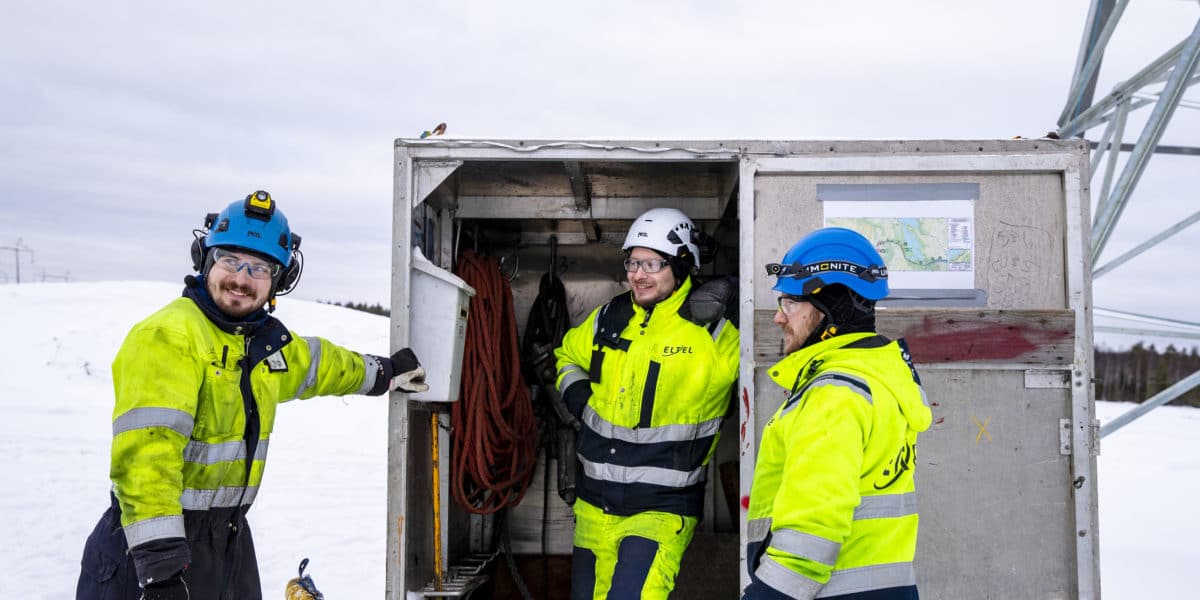Safety Supervisor Lauri Tolpanniemi begins his working day on Eltel’s transmission line construction site in Haapavesi. The contract ordered by Fingrid encompasses 58 kilometres of transmission lines from Karsikas to Rantsila.
Tolpanniemi is chatting with the worksite manager and installation technicians. Together, they go through the work phases for the day before each setting off to their work locations.
“My days involve work such as employee orientation and reviewing construction phases and occupational safety matters with the installation technicians,” Tolpanniemi says.
In Eno, on the other side of Finland, TMV Line Oy is building a power line from Kontiolahti to Palojärvi. Karri Immonen, the safety supervisor there, is about to start his working day.
“The first thing I do is go through the work phases for the day with the worksite manager, our personnel, and our subcontractors and think about the potential occupational safety risks. If there are no major occupational safety matters to review, the employees get to work on the transmission line worksite,” Immonen says.
During the day, Immonen tours the transmission line worksite with the worksite manager. The safety supervisor is the worksite manager’s right-hand man, so the pair work closely together.

Safety supervisors take weekly MVR measurements to monitor safety on land and water construction sites. The work also includes presenting Fingrid’s occupational safety campaigns and giving safety toolbox talks.
“There has been a lot of talk about the pandemic and the associated guidelines in recent times. Luckily, we have not had any cases of coronavirus on our worksite,” Immonen says.
Returning home healthy
The motto on Karri Immonen’s worksite is that people come to work healthy and go home healthy. However, there are some significant elevation differences and large swamplands around Eno, adding to the challenges of occupational safety.
“The installation technicians working in these challenging conditions are quite young and familiar with the safety regulations from their training. Naturally, they know the dangers of working at height, and it is a matter of course for them to wear safety shoes on difficult terrain and use other safety equipment,” Immonen says.
“We get a lot of snow and very low temperatures here in the winter. This demands a lot of our clothing and footwear. In the summer, it can be really hot, and we also need to take this into consideration when planning the work,” he adds.
“On the transmission line worksite, we work with powerful currents and heavy loads almost daily.”
Tolpanniemi also praises the diligence and attitude of the installation technicians:
“On the transmission line worksite, we work with powerful currents and heavy loads almost daily. Foresight and planning are absolutely essential for safety. Employees need the correct equipment, information, and expertise to work safely.”
Every employee carries out a regular risk assessment and gives their own ideas for improving safety. Safety is improved by taking into account the risks and highlighting them for everyone’s benefit, but something unpredictable can always happen, no matter how careful you are.
“On one occasion, a truck was towing another truck on the worksite when the towing truck’s tow bar suddenly came off and crashed through the windscreen of the other truck. Luckily, no one was injured. A near miss was reported, it was investigated thoroughly, and lessons were learned,” Tolpanniemi says.
Enhancing expertise together
Fingrid has interviewed, trained, and approved the safety supervisors for the worksites it has ordered. The job calls for specific expertise and training.
Lauri Tolpanniemi is trained as a mechanical and production engineer, and he previously worked as a warehouse foreman and delivery supervisor for a construction factory, as well as a trainer for the production function of a textile company. Karri Immonen is trained as a construction engineer, and he gained work experience in the housebuilding sector.
While work is ongoing on the worksite, Fingrid is constantly training safety supervisors in matters related to occupational safety, the environment, and quality. In addition, safety supervisors meet regularly to enhance their knowledge with colleagues and Fingrid’s safety specialists.
“The meetings cover the burning issues of the day, and we share best practices and harmonise our working methods. One goal is to develop the culture of safety more broadly,” says Markku Pöysti, Occupational Safety Expert at Fingrid.
In addition to meetings, Fingrid organises annual safety supervisor days on various themes. In November last year, the themes included the importance of earthing during work and carrying out risk assessments.






